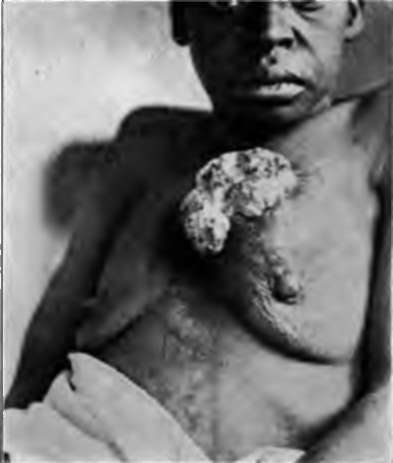Carcinoma By Extension
Description
This section is from the book "Skin Cancer", by Henry H. Hazen, A.B., M.D.. Also available from Amazon: Skin Cancer.
Carcinoma By Extension
Clinical Course
Now that the public is beginning to more fully appreciate the danger of lumps or tumors in any part of the body, the surgeon does not often see a case with ulceration through the skin, except after an unsuccessful operation. Fungating tumors of the skin are probably commoner after cancer of the breast than after any other type of cancer (Fig. 52), although it is not unusual for lymph glands, infected with cancerous material, to break down and form deep ulcers. Two clinical types of cancer by extension are seen-the fungating and the ulcerating. In the former a mass of papillomatous tissue extends through the skin. The color is somewhat that of dirty-looking granulation tissue, but always covered with a necrotic membrane. There is usually considerable discharge and the odor is very foul. In the ulcerating variety there is an ulcer of more or less depth, with a hard edge, dirty base, and a foul discharge.

Fig. 62.-Extension of carcinoma of the breast. (Author's collection).
Pathology
The pathology, of course, depends entirely on the variety of antecedent tumor.
Treatment
These conditions may at times be temporarily ameliorated by operation, but the chances for a permanent cure are very slim, although x-ray treatment has apparently cured a few, and radium promises something.
Continue to:
- prev: Chapter X. Carcinoma En Cuirasse-Carcinoma By Extension- Metastatic Carcinoma-Paget's Disease
- Table of Contents
- next: Metastatic Carcinomata
Tags
bookdome.com, books, online, free, old, antique, new, read, browse, download
